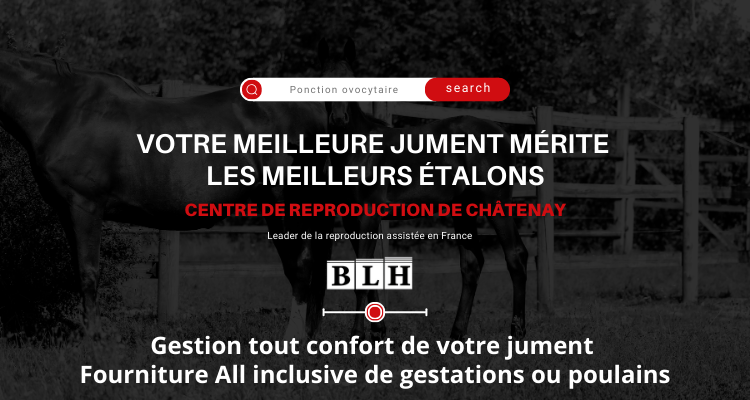𝐀𝐧𝐚𝐥𝐲𝐬𝐞 𝐂𝐨𝐦𝐩𝐚𝐫𝐚𝐭𝐢𝐯𝐞: 𝐏𝐨𝐧𝐜𝐭𝐢𝐨𝐧 𝐎𝐯𝐨𝐜𝐲𝐭𝐚𝐢𝐫𝐞 𝐞𝐭 𝐈𝐂𝐒𝐈 𝐯𝐬 𝐓𝐫𝐚𝐧𝐬𝐟𝐞𝐫𝐭 𝐝’𝐄𝐦𝐛𝐫𝐲𝐨𝐧 (𝐓𝐄) 𝐩𝐨𝐮𝐫 𝐥𝐚 𝐑𝐞𝐩𝐫𝐨𝐝𝐮𝐜𝐭𝐢𝐨𝐧 𝐚𝐯𝐞𝐜 “𝐂𝐨𝐦𝐦𝐞 𝐈𝐥 𝐅𝐚𝐮𝐭”
Breeding with world-renowned stallions such as “Comme Il Faut” requires the use of advanced reproductive techniques.
Two commonly used methods, oocyte puncture (OPU) followed by intracytoplasmic sperm injection (ICSI), and embryo transfer (ET), have different financial and practical implications.
This article compares the costs and risks associated with each of these methods, as follows.
𝐌𝐞́𝐭𝐡𝐨𝐝𝐞 𝐈𝐂𝐒𝐈 (𝐏𝐨𝐧𝐜𝐭𝐢𝐨𝐧 𝐎𝐯𝐨𝐜𝐲𝐭𝐚𝐢𝐫𝐞 & 𝐈𝐂𝐒𝐈)
𝑷𝒐𝒏𝒄𝒕𝒊𝒐𝒏 𝑶𝒗𝒐𝒄𝒚𝒕𝒂𝒊𝒓𝒆 (𝑶𝑷𝑼): €2,000
𝑪𝒐𝒖̂𝒕 𝒑𝒐𝒖𝒓 3 𝒆𝒎𝒃𝒓𝒚𝒐𝒏𝒔 (𝒈𝒆́𝒏𝒆́𝒕𝒊𝒒𝒖𝒆 𝒊𝒏𝒄𝒍𝒖𝒔𝒆): 3,000 €
𝑺𝒖𝒊𝒗𝒊 𝒈𝒚𝒏𝒆́𝒄𝒐𝒍𝒐𝒈𝒊𝒒𝒖𝒆 de 𝒋𝒖𝒎𝒆𝒏𝒕 𝒑𝒐𝒓𝒕𝒆𝒖𝒔𝒆 𝒇𝒐𝒖𝒓𝒏𝒊𝒆 : 150 €
𝑰𝒎𝒑𝒍𝒂𝒏𝒕𝒂𝒕𝒊𝒐𝒏 𝒆𝒎𝒃𝒓𝒚𝒐𝒏𝒏𝒂𝒊𝒓𝒆 : 400 €
𝑷𝒆𝒏𝒔𝒊𝒐𝒏 𝒅𝒆 𝒍𝒂 𝒋𝒖𝒎𝒆𝒏𝒕 (𝒎𝒐𝒚𝒆𝒏𝒏𝒆) : 150 €
➡️Total: €5,550 incl. VAT, with two additional embryos frozen for future use.
𝐓𝐫𝐚𝐧𝐬𝐟𝐞𝐫𝐭 𝐝’𝐄𝐦𝐛𝐫𝐲𝐨𝐧 (𝐓𝐄)
𝐒𝐮𝐢𝐯𝐢 𝐠𝐲𝐧𝐞́𝐜𝐨𝐥𝐨𝐠𝐢𝐪𝐮𝐞 𝐞𝐭 𝐦𝐢𝐬𝐞 𝐞𝐧 𝐩𝐥𝐚𝐜𝐞 : 700 €
𝐅𝐫𝐚𝐢𝐬 𝐯𝐞́𝐭𝐞́𝐫𝐢𝐧𝐚𝐢𝐫𝐞𝐬 𝐚𝐧𝐧𝐞𝐱𝐞𝐬 : 200-300€ €
𝑨𝒄𝒉𝒂𝒕 𝒅𝒆 𝒅𝒆𝒖𝒙 𝒅𝒐𝒔𝒆𝒔 𝒅𝒆 𝒔𝒆𝒎𝒆𝒏𝒄𝒆 + 𝒕𝒓𝒂𝒏𝒔𝒑𝒐𝒓𝒕: 2000 €
𝑻𝒓𝒂𝒏𝒔𝒇𝒆𝒓𝒕 𝒅’𝒆𝒎𝒃𝒓𝒚𝒐𝒏 (𝒎𝒐𝒚𝒆𝒏𝒏𝒆 𝒅𝒆 𝒅𝒆𝒖𝒙 𝒕𝒆𝒏𝒕𝒂𝒕𝒊𝒗𝒆𝒔) : 700 €
𝑴𝒊𝒔𝒆 𝒆𝒏 𝒑𝒍𝒂𝒄𝒆 𝒅𝒆 𝒍’𝒆𝒎𝒃𝒓𝒚𝒐𝒏 : 200 €
𝑷𝒆𝒏𝒔𝒊𝒐𝒏 𝒅𝒆 𝒍𝒂 𝒋𝒖𝒎𝒆𝒏𝒕 (𝒎𝒐𝒚𝒆𝒏𝒏𝒆) : 400 €
𝑺𝒖𝒊𝒗𝒊 𝒅𝒆 𝒍𝒂 𝒋𝒖𝒎𝒆𝒏𝒕 𝒑𝒐𝒓𝒕𝒆𝒖𝒔𝒆 + 𝒑𝒆𝒏𝒔𝒊𝒐𝒏 𝒑𝒐𝒓𝒕𝒆𝒖𝒔𝒆 : 500 €
➡️Total : €4,7500 (excluding surrogate mare rental and with a 50% chance of not obtaining a pregnancy).
𝗣𝗼𝗶𝗻𝘁𝘀 𝗖𝗹𝗲́𝘀 𝗮̀ 𝗖𝗼𝗻𝘀𝗶𝗱𝗲́𝗿𝗲𝗿
𝐂𝐨𝐦𝐩𝐚𝐫𝐚𝐢𝐬𝐨𝐧 𝐝𝐞𝐬 𝐂𝐨𝐮̂𝐭𝐬
👉At first glance, ICSI’s total cost of €5,550 seems higher than TE’s €4,750.
However, several elements MUST be taken into account:
👉The cost of ICSI includes 𝐭𝐫𝐨𝐢𝐬 𝐞𝐦𝐛𝐫𝐲𝐨𝐧𝐬 𝐞𝐧 𝐦𝐨𝐲𝐞𝐧𝐧𝐞, two of which are frozen, thus offering future gestation opportunities without significant additional costs.
👉TE costs do not include the potential need to hire a surrogate mare, which could increase expenses.
𝗧𝗮𝘂𝘅 𝗱𝗲 𝗥𝗲́𝘂𝘀𝘀𝗶𝘁𝗲 𝗲𝘁 𝗥𝗶𝘀𝗾𝘂𝗲𝘀
Both methods have similar embryo survival rates, generally between 70 and 80%, depending on the age of the donor mare.
However, the probability of failure – i.e. not achieving pregnancy – is much higher with TE.
The risk of failure is 12 times higher with TE than with ICSI , where the production of several embryos per cycle increases the chances of success.
( For Comme Il Faut , we have assumed a fertility rate of 35% per insemination cycle and 3 embryos per ICSI cycle.)
𝑨𝒗𝒂𝒏𝒕𝒂𝒈𝒆𝒔 𝑳𝒐𝒈𝒊𝒔𝒕𝒊𝒒𝒖𝒆𝒔
ICSI offers a logistical advantage when it comes to managing carrier mares.
It is often difficult to perfectly synchronize a carrier mare for a TE, which can lead to higher rejection rates or the need to rent mares from the implantation center .
With ICSI, the process is simplified, as embryos are frozen and can be implanted at the ideal time, facilitating the coordination of carrier mares.
𝐂𝐨𝐧𝐜𝐥𝐮𝐬𝐢𝐨𝐧
Although the initial costs of ICSI are higher (and still higher) than those of TE, the added value of additional embryos, the reduced risk of failure and the ease of managing carrier mares make ICSI a more predictable and potentially more cost-effective option in the long term.
𝐋𝐞 𝐫𝐢𝐬𝐪𝐮𝐞 𝐟𝐢𝐧𝐚𝐧𝐜𝐢𝐞𝐫 𝐝’𝐞́𝐜𝐡𝐞𝐜 𝐞𝐬𝐭 𝐜𝐨𝐧𝐬𝐢𝐝𝐞́𝐫𝐚𝐛𝐥𝐞𝐦𝐞𝐧𝐭 𝐫𝐞́𝐝𝐮𝐢𝐭, and embryo cryopreservation offers breeders greater flexibility.
So, for breeders wishing to maximize the genetic potential of elite stallions like “Comme Il Faut”, the ICSI method stands out as the most reliable and potentially most economical option, especially considering the higher risk of failure inherent in TE.
